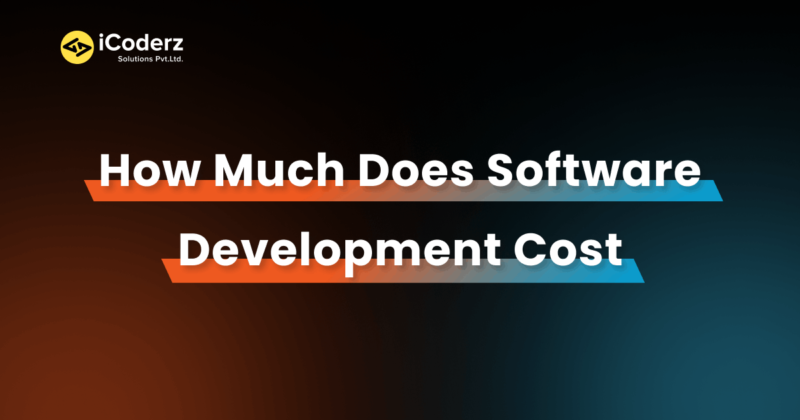Table of Contents
Are you tired of your software development projects going over budget? Do you want to learn about the factors that affect software development costs and how to reduce them? Look no further! In this blog post, we will explore the factors contributing to high software development prices and provide practical tips for controlling those expenses. We’ve got you covered, from proper planning and team management to utilizing technology and open-source solutions. So let’s dive in and discover how you can save the cost of software development while delivering top-notch software products.
The global software development market was valued at $425.75 billion in 2020 and is projected to reach $697.28 billion by 2025, with a CAGR of 10.3% during the forecast period.
North America is the largest software development market, followed by Europe and the Asia-Pacific region.
Understanding the Basics of Software Development Cost Estimation
Estimating the cost of software development can be a complex and challenging process. However, it is critical to have an accurate estimate to ensure that the project is completed within budget and on time. Here are some steps that can help in estimating the Software Development Cost:
Software Development Costs Based Upon Size
Small-scale Projects:
- Basic mobile app: $10,000 to $50,000
- Landing page or simple website: $5,000 to $20,000
- Content management system (CMS) setup: $10,000 to $30,000
- API integration: $5,000 to $20,000
Medium-scale Projects:
- Custom web application with multiple modules: $50,000 to $250,000
- E-commerce website with inventory management: $50,000 to $200,000
- Customer relationship management (CRM) system: $100,000 to $500,000
- Mobile app with backend server: $50,000 to $300,000
Large-scale Projects:
- Enterprise resource planning (ERP) system: $500,000 to $2,000,000+
- Complex software platform with third-party integrations: $1,000,000 to $5,000,000+
- Custom software suite for a specific industry: $1,000,000 to $10,000,000+
- High-end mobile app with advanced features: $200,000 to $1,000,000+
Software Development Costs Based Upon Location
United States and Canada:
- Hourly rates: $100 to $200+
- Small-scale project: $50,000 to $500,000+
- Medium-scale project: $100,000 to $1,000,000+
- Large-scale project: $500,000 to $10,000,000+
Western Europe (e.g., United Kingdom, Germany, France):
- Hourly rates: €80 to €150+
- Small-scale project: €40,000 to €400,000+
- Medium-scale project: €80,000 to €800,000+
- Large-scale project: €400,000 to €8,000,000+
Eastern Europe (e.g., Ukraine, Poland, Romania):
- Hourly rates: $30 to $80
- Small-scale project: $10,000 to $200,000
- Medium-scale project: $50,000 to $500,000
- Large-scale project: $200,000 to $5,000,000
Asia (e.g., India, China, Philippines):
- Hourly rates: $20 to $60
- Small-scale project: $5,000 to $100,000
- Medium-scale project: $20,000 to $300,000
- Large-scale project: $100,000 to $3,000,000
Factors that Affect Software Development Cost
Software development costs can be influenced by various factors, ranging from the size and scope of the project to the technology used to build it. Understanding these factors can help organizations plan and budget software development projects effectively. Here are some of the most important factors affecting software development cost:
- Project Size and Scope: The size and scope of a project are one of the primary factors affecting software development costs. Larger projects generally require more resources, including time, personnel, and technology. The more complex a project is, the more time and effort it will take to complete, leading to higher costs.
- Technology Used: The technology used to develop software can also affect the cost. Some technologies are more complex and require more specialized skills to develop, which can increase costs. On the other hand, simpler technologies may be less expensive to develop but may not offer the same level of functionality.
- Development Methodology: The methodology used to develop software can also impact the cost. For example, agile development methodologies typically involve more frequent iterations and testing, which can lead to increased costs. In contrast, traditional waterfall methodologies may involve more upfront planning and design but may be less expensive overall.
- Skill and Experience of the Development Team: The skill and experience of the development team can also impact the cost of software development. More experienced developers may be able to complete tasks more efficiently and with fewer errors, reducing the project’s overall cost. However, more experienced developers may also command higher salaries, which can increase the project’s cost.
- Project Management: Effective project management is critical to controlling software development costs. Poor project management can lead to delays, cost overruns, and other problems that can increase the project’s cost. Effective project management practices, such as clear communication, effective risk management, and regular status updates, can help keep costs in check.
- Testing and Quality Assurance: Testing and quality assurance are critical components of software development that can impact the project’s cost. More thorough testing and quality assurance can help ensure that the software meets the requirements and functions as intended, but it can also increase the time and cost of development.
- Integration with Existing Systems: If the software being developed needs to integrate with existing systems, this can also impact the cost of development. Integration can be complex and require specialized skills, which can increase the project’s cost.
- Security and Compliance Requirements: Security and compliance requirements can also affect the cost of software development. Implementing robust security measures and ensuring compliance with relevant regulations can be time-consuming and require specialized skills, which can increase costs.

How to Reduce Software Development Costs
Reducing software development costs is a key goal for many organizations. Here are some strategies that can be used to help reduce software development costs:
- Optimize Development Processes: One of the most effective ways to reduce software development costs is to optimize development processes. This can involve adopting agile methodologies, streamlining workflows, and automating repetitive tasks. By optimizing processes, organizations can reduce the time and effort required for development, which can help to reduce costs.
- Use Open-Source Technologies: Open-source technologies can be a cost-effective alternative to proprietary software. Many open-source technologies are free to use and can be customized to meet the organization’s needs. By using open-source technologies, organizations can reduce the cost of software development without sacrificing functionality.
- Outsource Development: Outsourcing software development to lower-cost countries can be an effective way to reduce costs. This can involve Hiring a Dedicated Team of Software Developers or working with a software development company. Outsourcing development allows organizations to take advantage of lower labour costs without sacrificing quality.
👉 ALSO READ: Why IT Outsourcing Is Important for Small Businesses?
- Emphasize Reusability and Modularity: Developing software with reusability and modularity in mind can help to reduce costs in the long term.
- Perform Thorough Testing: Thorough testing can help reduce software development costs by identifying and resolving issues early in development. By performing thorough testing, organizations can avoid costly rework and ensure the software meets the requirements.
- Use Cloud Computing: Cloud computing can be a cost-effective alternative to traditional on-premise computing. By using cloud computing services, organizations can avoid the costs of hardware and infrastructure maintenance while also benefiting from greater flexibility and scalability.
👉 ALSO READ: Cloud Computing in Healthcare: How Technology is Improving the Industry
- Focus on User-Centered Design: User-centered design can help to reduce the cost of software development by ensuring that the software meets the needs of its users. By focusing on user-centred design, organizations can avoid costly rework and ensure the software is intuitive and easy to use.
Factors to Consider When Choosing a Software Provider
- Industry Expertise: Choosing a software provider with expertise in your industry is important. This ensures that the software is tailored to your industry’s specific needs and requirements and can help ensure that it is effective and efficient.
- Quality of Products: The quality of the software products offered by the provider is a critical factor to consider. The software should be reliable, easy to use, and meet the requirements of the organization. It is important to evaluate the software and read reviews from other customers before making a decision.
- Scalability: Choosing a software provider that offers scalable solutions that can grow with the organization is important. This ensures that the software can meet the organization’s changing needs and accommodate increases in users or data.
- Integration Capabilities: The software provider should offer integration capabilities with other systems or software used by the organization. This helps to ensure that the software can be seamlessly integrated with other business processes and systems and can help to streamline workflows.
- Security: The software provider should have robust security measures to protect against data breaches and cyber-attacks. This includes measures such as data encryption, secure access controls, and regular security updates.
- Support and Maintenance: The software provider should offer comprehensive support and maintenance services. This includes technical support, training, and regular software updates to ensure that the software remains up-to-date and effective.
- Cost: The cost of the software and associated services is an important factor to consider. It is important to evaluate the cost of the software against the features and functionality offered, as well as the long-term costs associated with support, maintenance, and upgrades.

Tips for Choosing a Reliable Software Provider
Choosing a reliable software provider is a critical decision for any organization. Here are some tips to help you choose a reliable software provider:
- Evaluate their Experience and Expertise: Choose a software provider with a proven success track record. Look for providers with experience in your industry who can demonstrate expertise in their technology and tools.
- Check their Customer References: Ask the software provider for customer references and speak to their existing customers to understand their experience with the provider. This can give you valuable insights into the provider’s reliability, customer service, and overall quality.
- Evaluate their Support and Maintenance Offerings: A reliable software provider will offer comprehensive support and maintenance services. Ensure they provide reliable technical support, regular updates, and training to help you make the most of your software.
- Look for Scalability: Choose a software provider that can offer scalable solutions to meet your organization’s growing needs. This will ensure your software can keep up with changing requirements without requiring expensive upgrades or replacements.
- Consider Their Security Measures: The software provider you choose should have robust security measures to protect sensitive data. Look for providers that have industry-standard security certifications and offer regular security updates.
- Evaluate Their Pricing Model: The cost of software is an important factor to consider, but be wary of providers offering extremely low prices, as this could indicate poor quality. Look for providers that offer transparent pricing models based on the features and services you need.
- Evaluate their Development Process: Choose a software provider with a structured development process and a clear project management methodology. This will help ensure that your software is delivered on time, on budget, and to the expected quality.
Conclusion
Software development costs can vary greatly depending on the complexity and size of the project. By understanding the factors that affect software development cost and taking steps to reduce them, you can create a more efficient system for developing your software without sacrificing quality or functionality. With careful planning, budgeting and research, you will be able to make sure that you get the most out of your software development projects while minimizing their costs.





